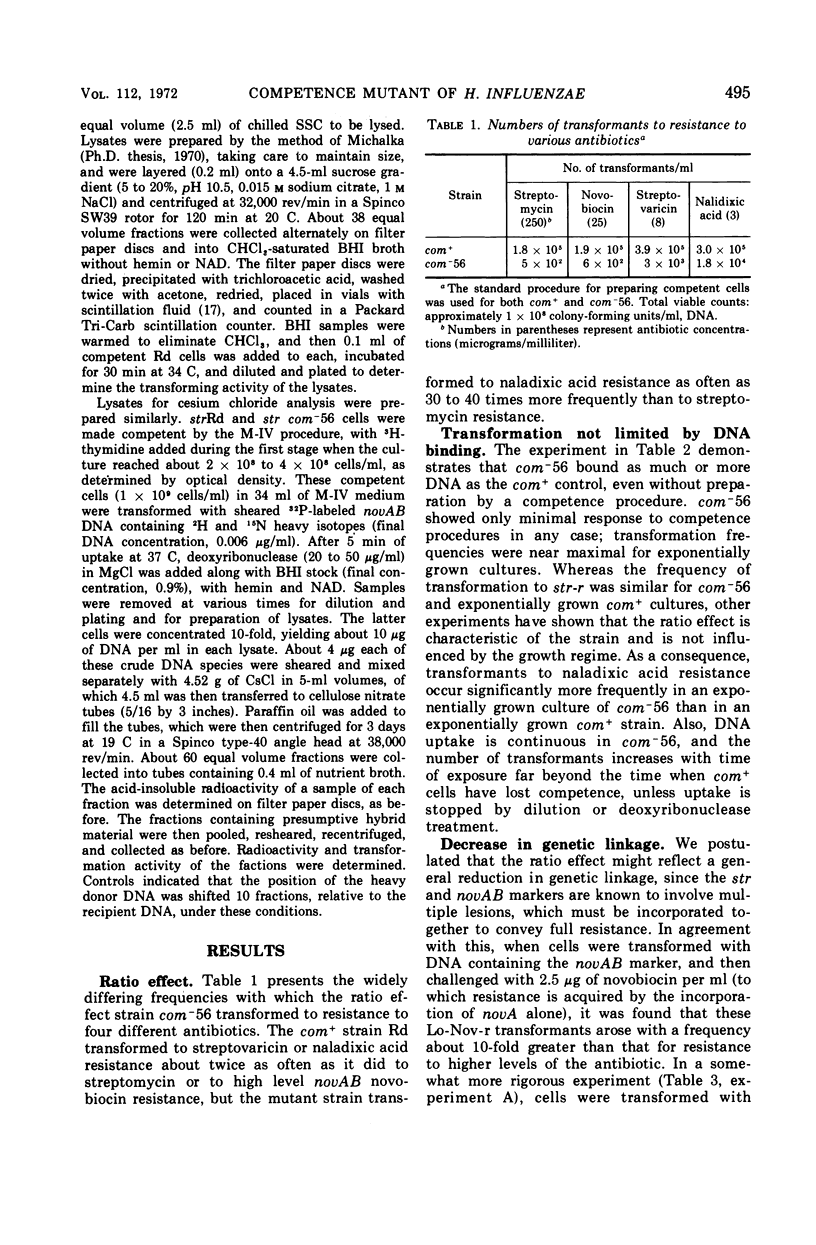Abstract
In studies of competence-deficient mutants of Haemophilus influenzae which absorb deoxyribonucleic acid (DNA) but fail to produce transformants, it was observed that in some mutants the residual transforming activity for different markers varied widely, i.e., produced a ratio effect. One of these mutants, com−56, was studied intensively to determine the cause of the residual efficiency of transformation and the reason for the ratio effect. The residual frequency of transformation was higher for markers considered single-site mutations (like naladixic acid resistance), whereas the least efficient markers tested were those conferring resistance to high levels of streptomycin or novobiocin which are more complex than single-site mutations. Measurement of frequencies of cotransformation indicated that overall genetic linkage was reduced. Transfection was fairly efficient with phage S2 DNA, but not prophage DNA. Donor marker activity could be detected in transformed cell lysates, but not linked to recipient markers in recombinant molecules. Sucrose gradient analysis of such lysates revealed that donor material was associated with recipient DNA in at least normal quantities, but lacked detectable genetic activity. Material from donor DNA labeled with heavy isotopes was incorporated into recipient chromosomal fragments having a density indistinguishable from normal density, unlike the hybrid density recombinant material found in normal cells. No excessive solubilization or nicking of unincorporated donor was detected. It is postulated that this strain contains a hyperactive nuclease, which reduces the effective size of the input DNA during the integration process.
Full text
PDF










Selected References
These references are in PubMed. This may not be the complete list of references from this article.
- ALEXANDER H. E., LEIDY G. Induction of streptomycin resistance in sensitive Hemophilus influenzae by extracts containing desoxyribonucleic acid from resistant Hemophilus influenzae. J Exp Med. 1953 Jan;97(1):17–31. doi: 10.1084/jem.97.1.17. [DOI] [PMC free article] [PubMed] [Google Scholar]
- BARNHART B. J., HERRIOTT R. M. PENETRATION OF DEOXYRIBONUCLEIC ACID INTO HEMOPHILUS INFLUENZAE. Biochim Biophys Acta. 1963 Sep 17;76:25–39. [PubMed] [Google Scholar]
- Bendler J. W., Goodgal S. H. Prophage S2 mutants in Haemophilus influenzae: a technique for their production and isolation. Science. 1968 Oct 25;162(3852):464–465. doi: 10.1126/science.162.3852.464. [DOI] [PubMed] [Google Scholar]
- Carmody J. M., Herriott R. M. Thymine and thymidine uptake by Haemophilus influenzae and the labeling of deoxyribonucleic acid. J Bacteriol. 1970 Feb;101(2):525–530. doi: 10.1128/jb.101.2.525-530.1970. [DOI] [PMC free article] [PubMed] [Google Scholar]
- Caster J. H., Postel E. H., Goodgal S. H. Competence mutants: isolation of transformation deficient strains of Haemophilus influenzae. Nature. 1970 Aug 1;227(5257):515–517. doi: 10.1038/227515a0. [DOI] [PubMed] [Google Scholar]
- Clark A. J. Toward a metabolic interpretation of genetic recombination of E. coli and its phages. Annu Rev Microbiol. 1971;25:437–464. doi: 10.1146/annurev.mi.25.100171.002253. [DOI] [PubMed] [Google Scholar]
- Curtiss R., 3rd Bacterial conjugation. Annu Rev Microbiol. 1969;23:69–136. doi: 10.1146/annurev.mi.23.100169.000441. [DOI] [PubMed] [Google Scholar]
- Day R. S., 3rd, Rupert C. S. Ultraviolet sensitivity of Haemophilus influenzae transforming DNA. I. Effects of genetic mismatch and target size. Mutat Res. 1971 Mar;11(3):293–311. [PubMed] [Google Scholar]
- Demerec M., Adelberg E. A., Clark A. J., Hartman P. E. A proposal for a uniform nomenclature in bacterial genetics. Genetics. 1966 Jul;54(1):61–76. doi: 10.1093/genetics/54.1.61. [DOI] [PMC free article] [PubMed] [Google Scholar]
- Frankel F. R. Studies on the nature of replicating DNA in T4-infected Escherichia coli. J Mol Biol. 1966 Jun;18(1):127–143. doi: 10.1016/s0022-2836(66)80081-5. [DOI] [PubMed] [Google Scholar]
- GOODGAL S. H., HERRIOTT R. M. Studies on transformations of Hemophilus influenzae. I. Competence. J Gen Physiol. 1961 Jul;44:1201–1227. doi: 10.1085/jgp.44.6.1201. [DOI] [PMC free article] [PubMed] [Google Scholar]
- Goodgal S. H., Postel E. H. On the mechanism of integration following transformation with single-stranded DNA of Hemophilus influenzae. J Mol Biol. 1967 Sep 14;28(2):261–273. doi: 10.1016/s0022-2836(67)80008-1. [DOI] [PubMed] [Google Scholar]
- HARM W., RUPERT C. S. INFECTION OF TRANSFORMABLE CELLS OF HAEMOPHILUS INFLUENZAE BY BACTERIOPHAGE AND BACTERIOPHAGE DNA. Z Vererbungsl. 1963 Dec 30;94:336–348. doi: 10.1007/BF00897593. [DOI] [PubMed] [Google Scholar]
- Herriott R. M., Meyer E. M., Vogt M. Defined nongrowth media for stage II development of competence in Haemophilus influenzae. J Bacteriol. 1970 Feb;101(2):517–524. doi: 10.1128/jb.101.2.517-524.1970. [DOI] [PMC free article] [PubMed] [Google Scholar]
- Herriott R. M., Meyer E. Y., Vogt M., Modan M. Defined medium for growth of Haemophilus influenzae. J Bacteriol. 1970 Feb;101(2):513–516. doi: 10.1128/jb.101.2.513-516.1970. [DOI] [PMC free article] [PubMed] [Google Scholar]
- Hotchkiss R. D., Gabor M. Bacterial transformation, with special reference to recombination process. Annu Rev Genet. 1970;4:193–224. doi: 10.1146/annurev.ge.04.120170.001205. [DOI] [PubMed] [Google Scholar]
- Michalka J., Goodgal S. H. Genetic and physical map of the chromosome of Hemophilus influenzae. J Mol Biol. 1969 Oct 28;45(2):407–421. doi: 10.1016/0022-2836(69)90115-6. [DOI] [PubMed] [Google Scholar]
- Notani N. K., Goodgal S. H. Decrease in integration of transforming DNA of Hemophilus influenzae following ultraviolet irradiation. J Mol Biol. 1965 Sep;13(2):611–613. doi: 10.1016/s0022-2836(65)80126-7. [DOI] [PubMed] [Google Scholar]
- Postel E. H., Goodgal S. H. Competence mutants. 3. Responses to radiations. J Bacteriol. 1972 Jan;109(1):298–306. doi: 10.1128/jb.109.1.298-306.1972. [DOI] [PMC free article] [PubMed] [Google Scholar]
- Postel E. H., Goodgal S. H. Competence mutants. II. Physical and biological fate of donor transforming deoxyribonucleic acid. J Bacteriol. 1972 Jan;109(1):292–297. doi: 10.1128/jb.109.1.292-297.1972. [DOI] [PMC free article] [PubMed] [Google Scholar]
- Steinhart W. L., Herriott R. M. Genetic integration in the heterospecific transformation of Haemophilus influenzae cells by Haemophilus parainfluenzae deoxyribonucleic acid. J Bacteriol. 1968 Nov;96(5):1725–1731. doi: 10.1128/jb.96.5.1725-1731.1968. [DOI] [PMC free article] [PubMed] [Google Scholar]
- Stuy J. H. Fate of transforming DNA in the Haemophilus influenzae transformation system. J Mol Biol. 1965 Sep;13(2):554–570. doi: 10.1016/s0022-2836(65)80117-6. [DOI] [PubMed] [Google Scholar]
- Voll M. J., Goodgal S. H. Loss of activity of transforming deoxyribonucleic acid after uptake by Haemophilus influenzae. J Bacteriol. 1965 Oct;90(4):873–883. doi: 10.1128/jb.90.4.873-883.1965. [DOI] [PMC free article] [PubMed] [Google Scholar]


